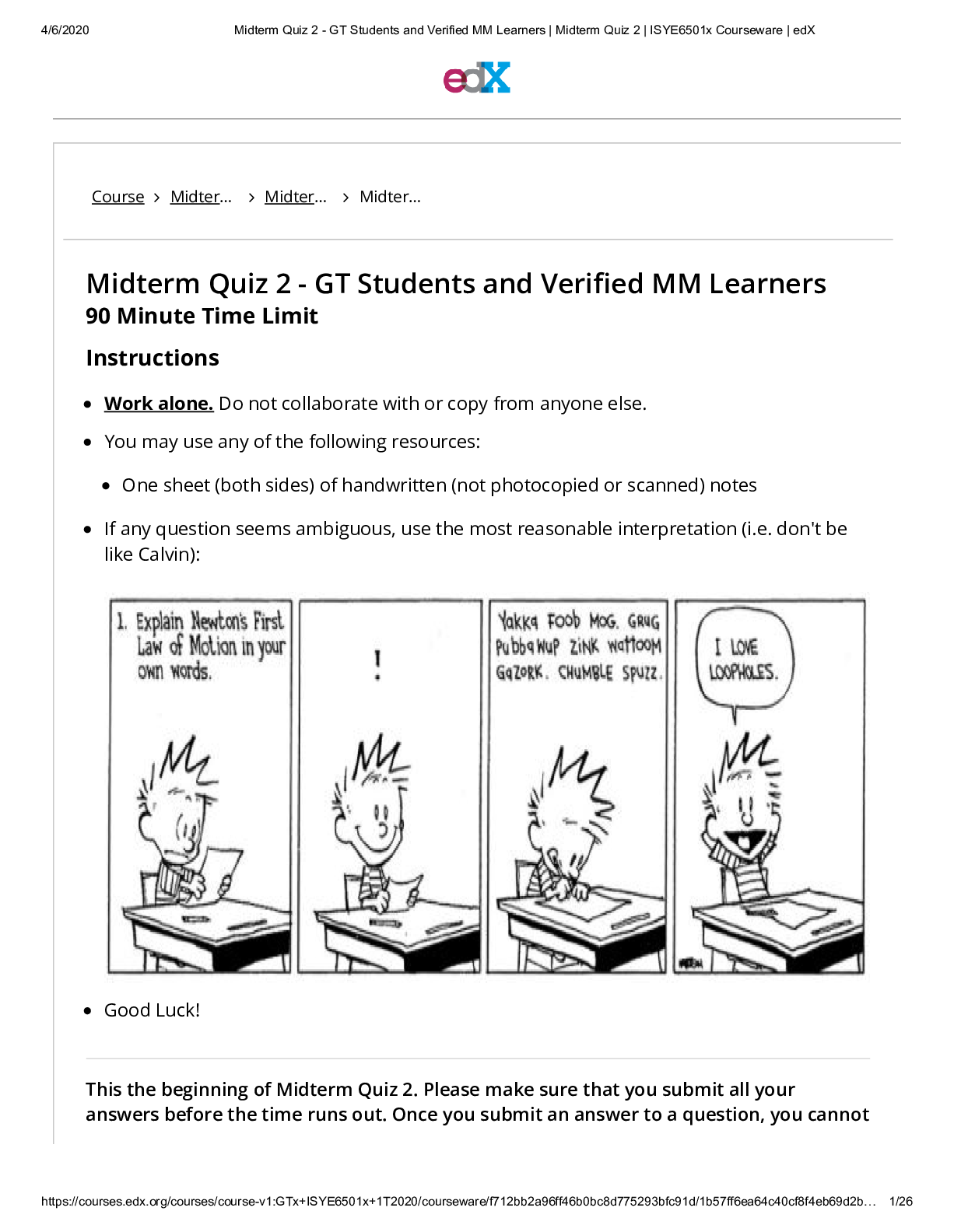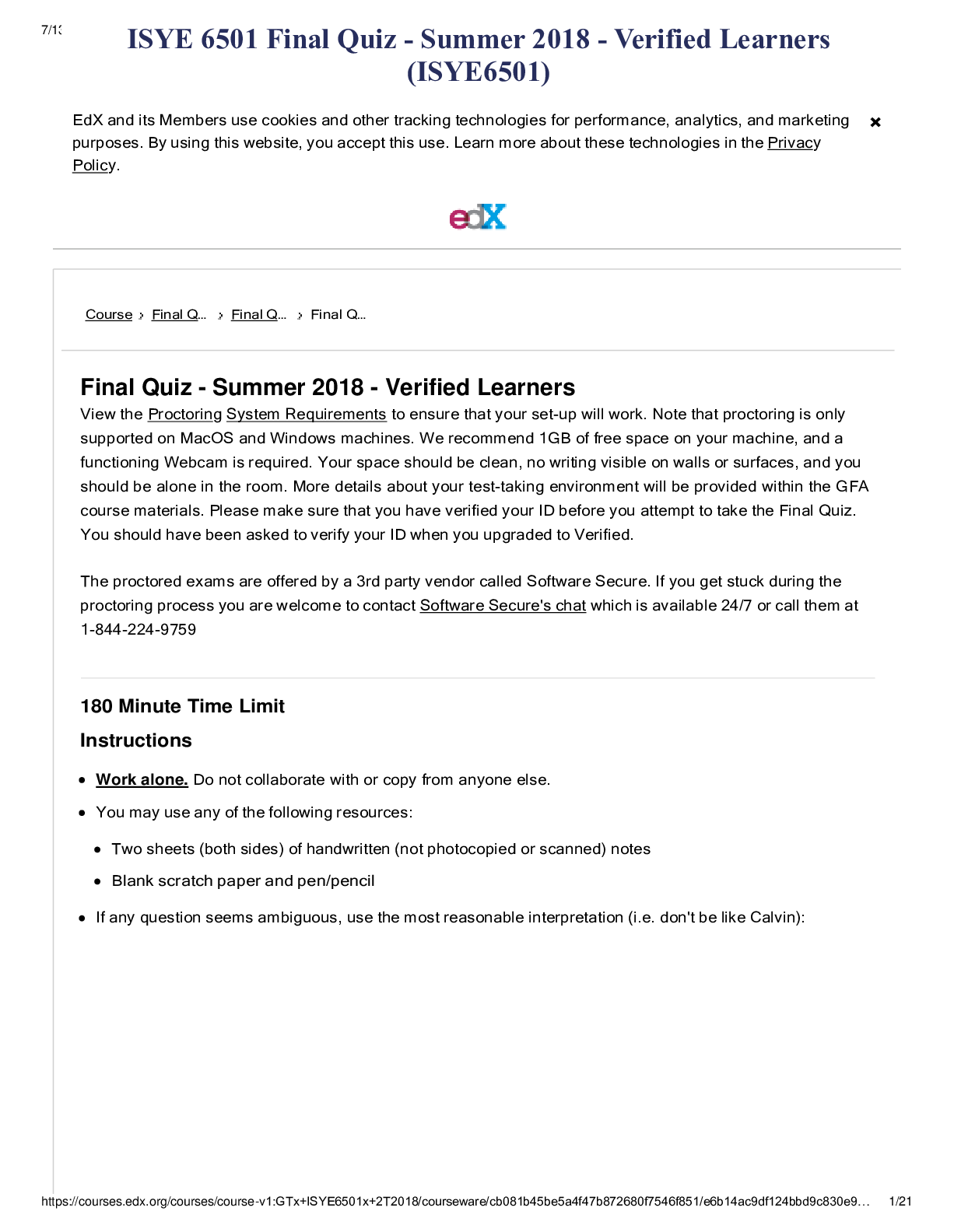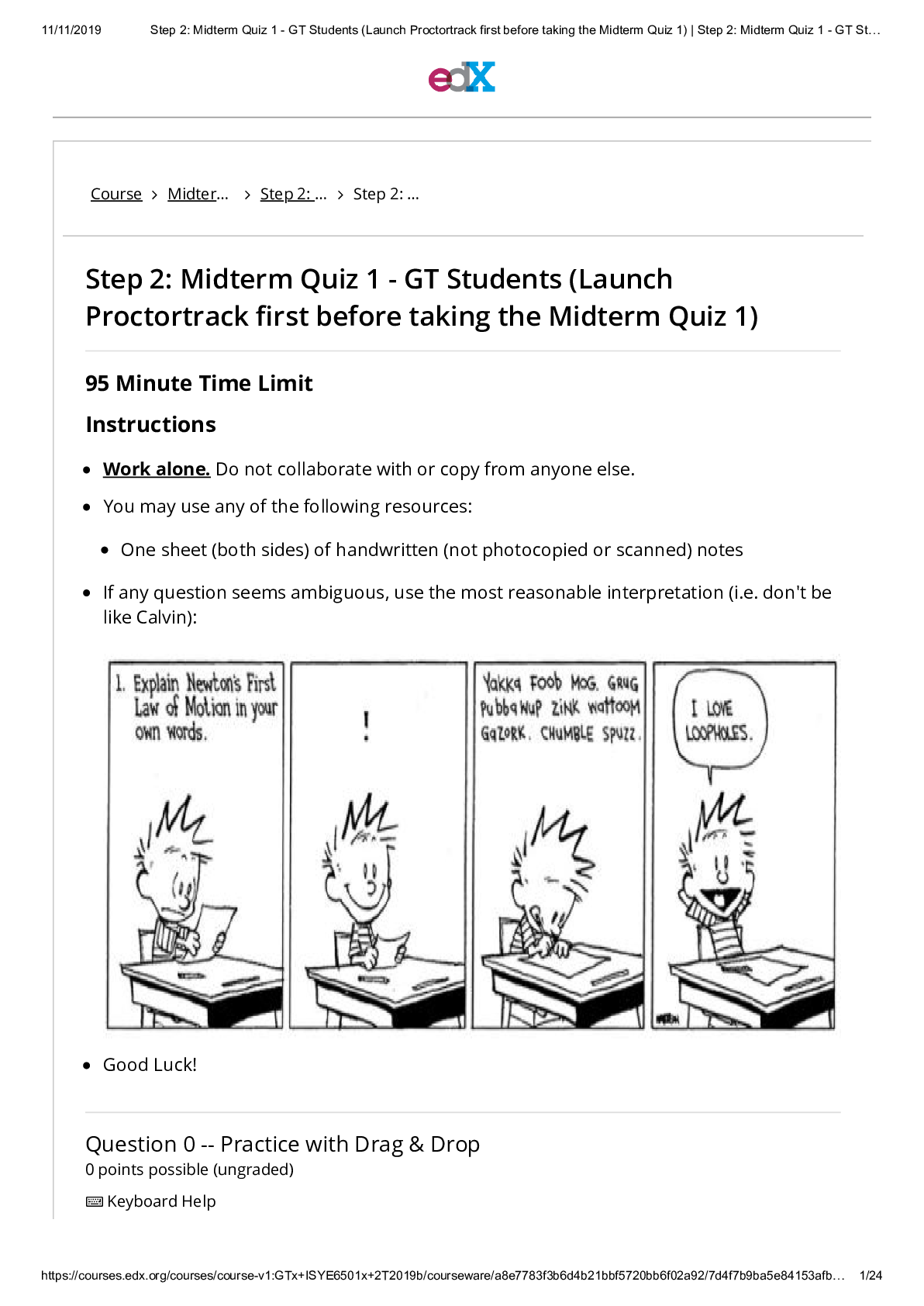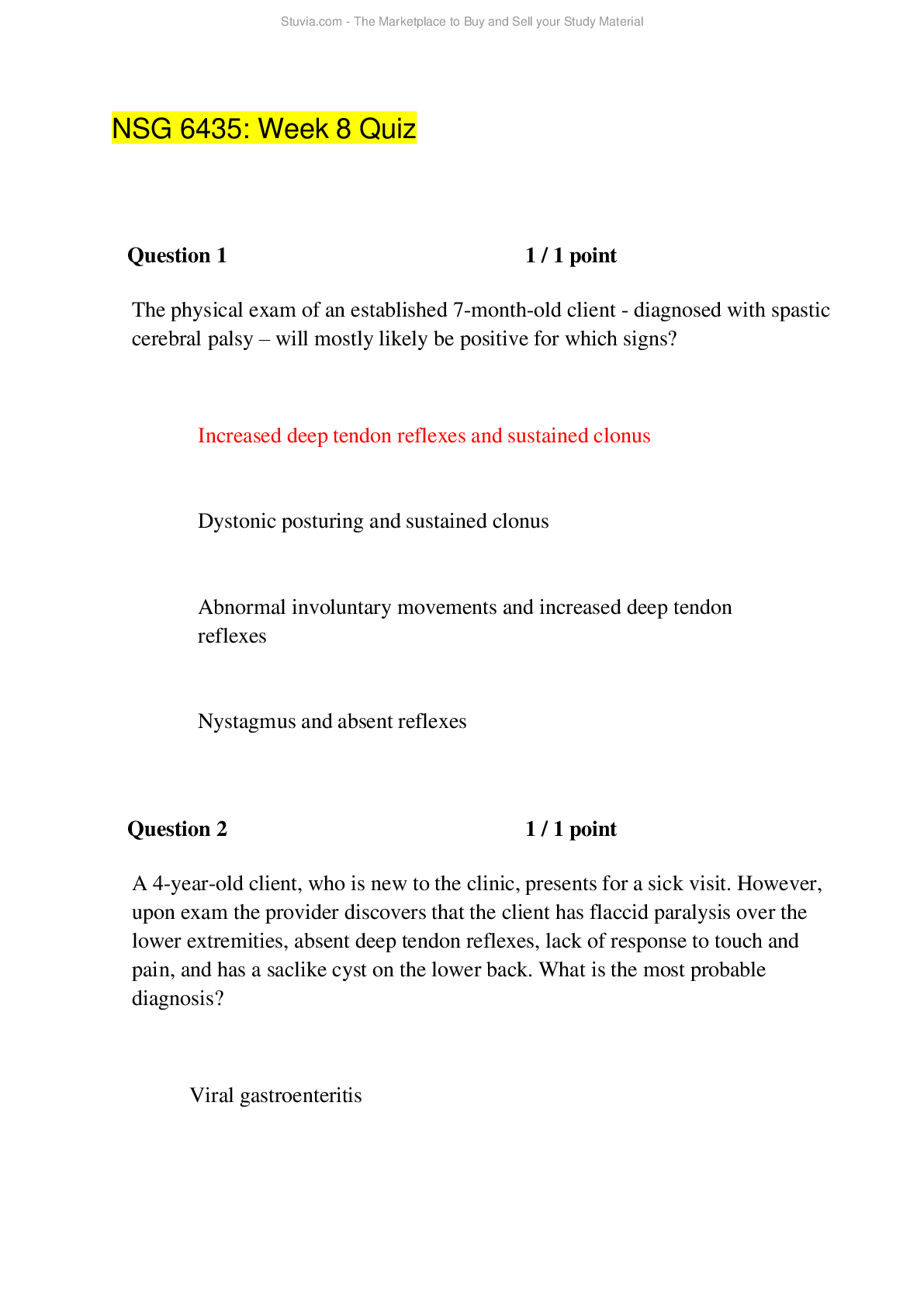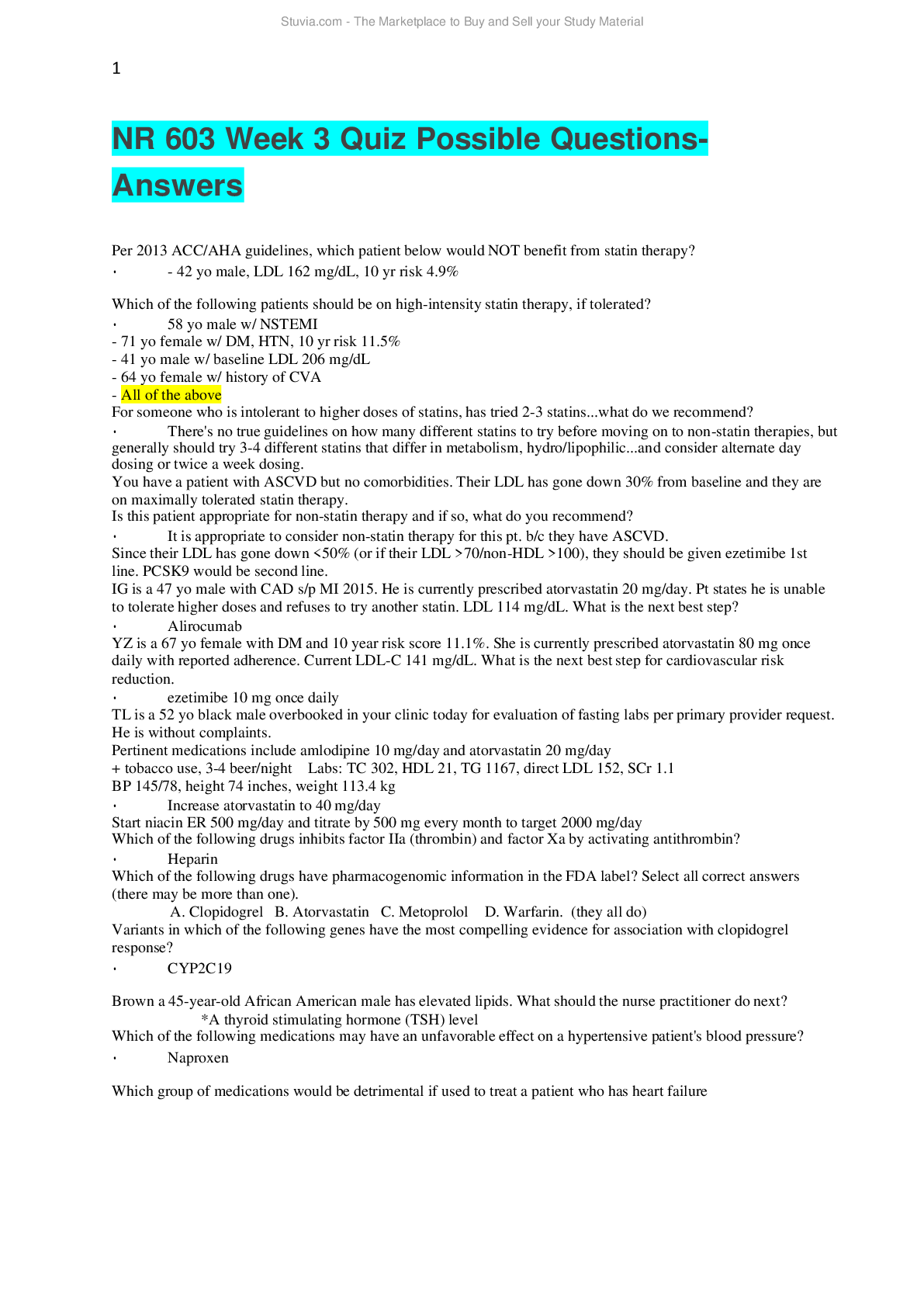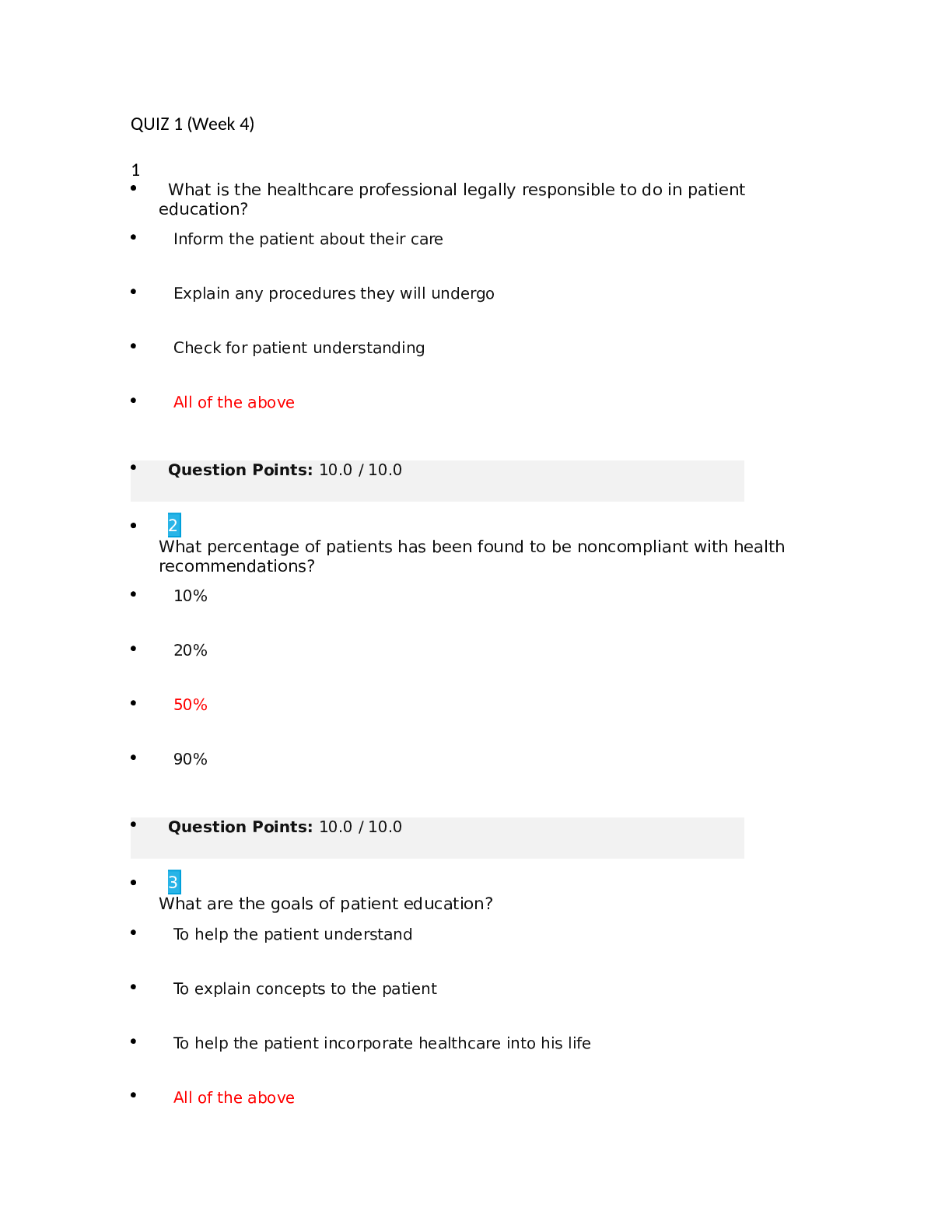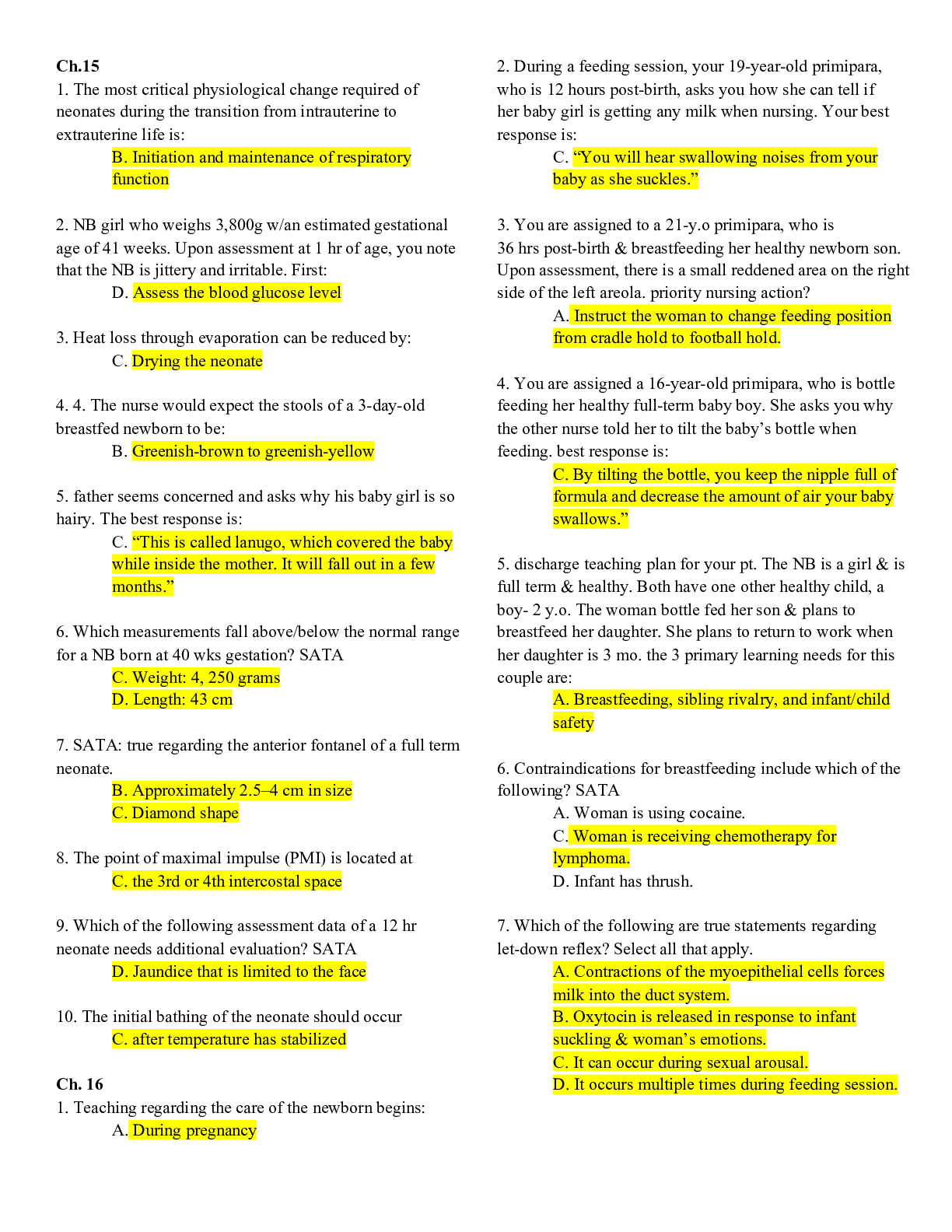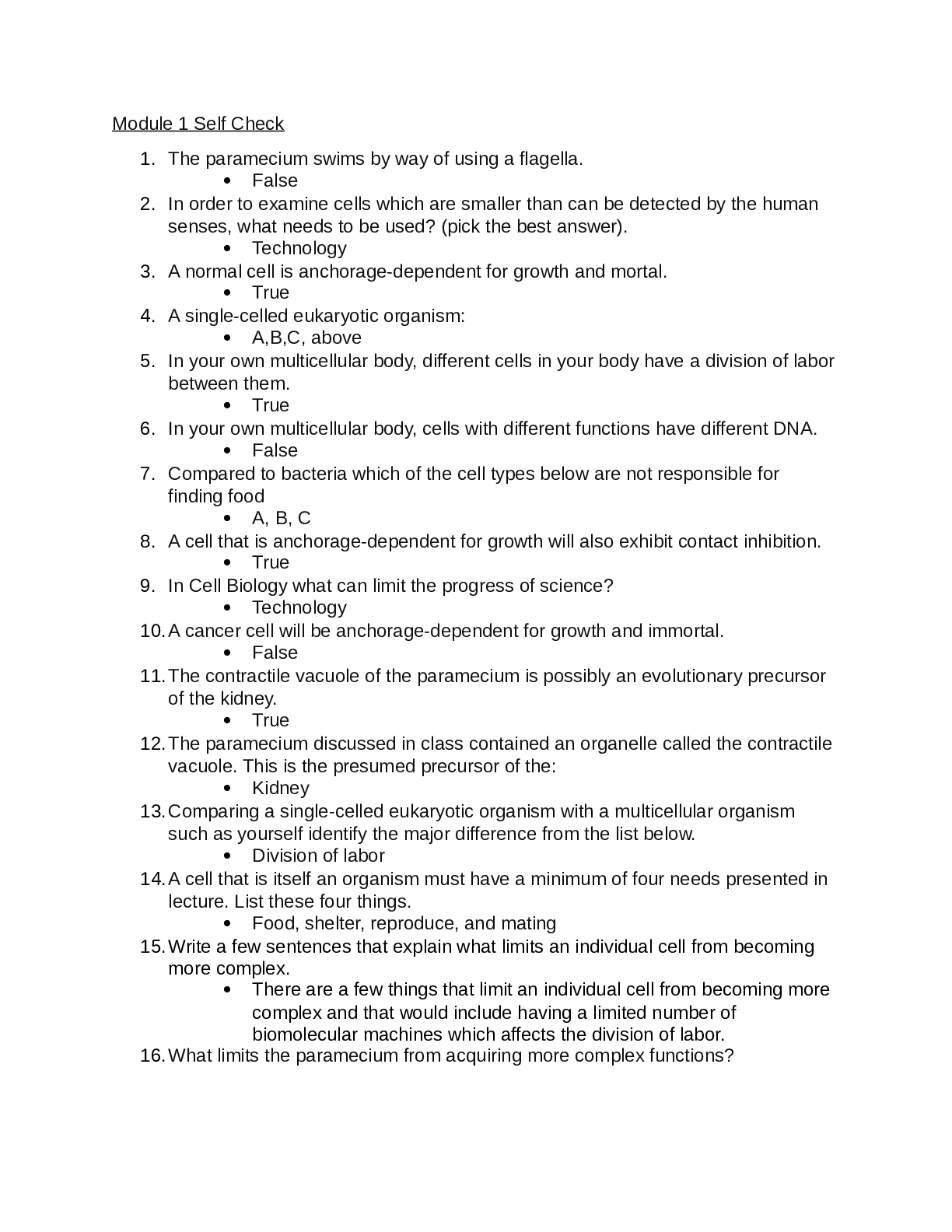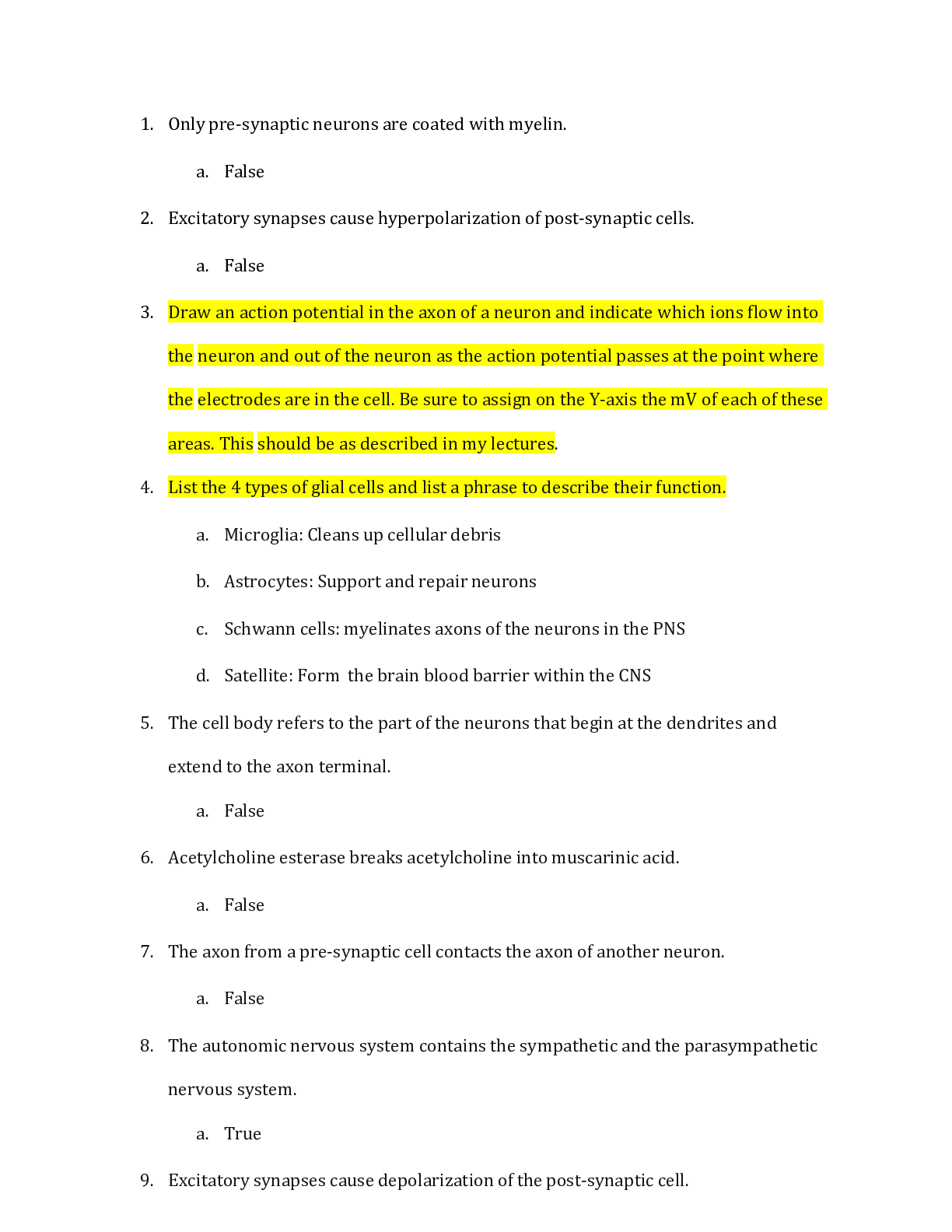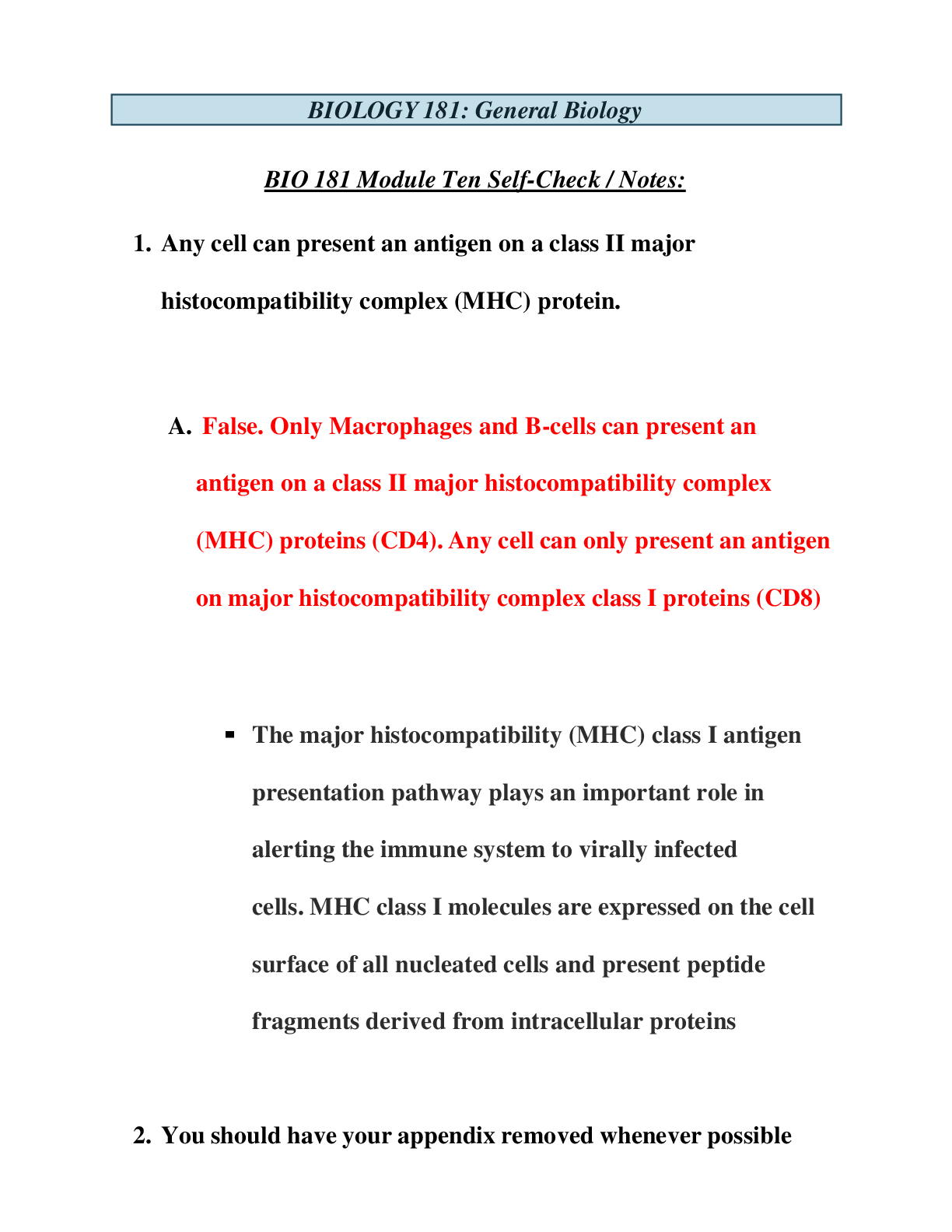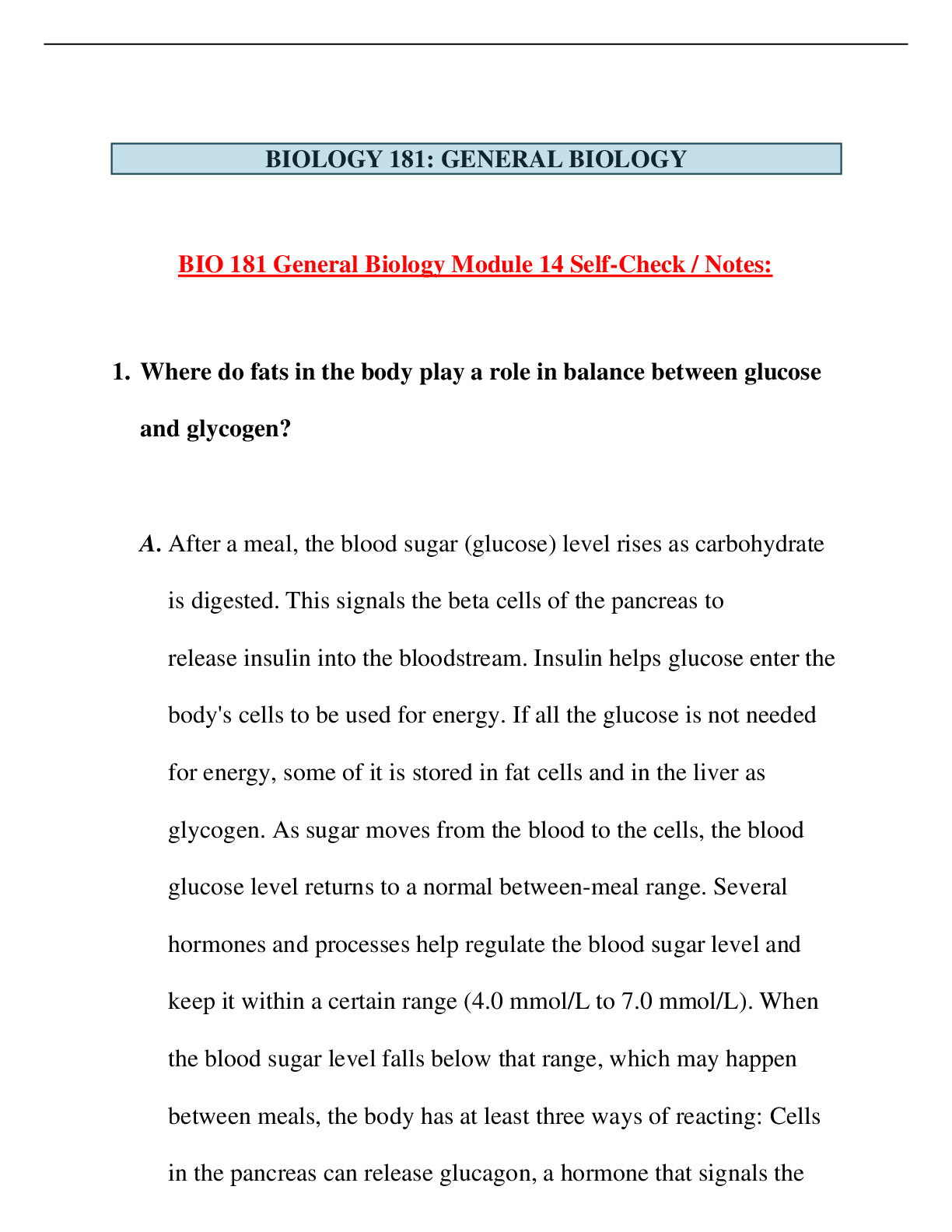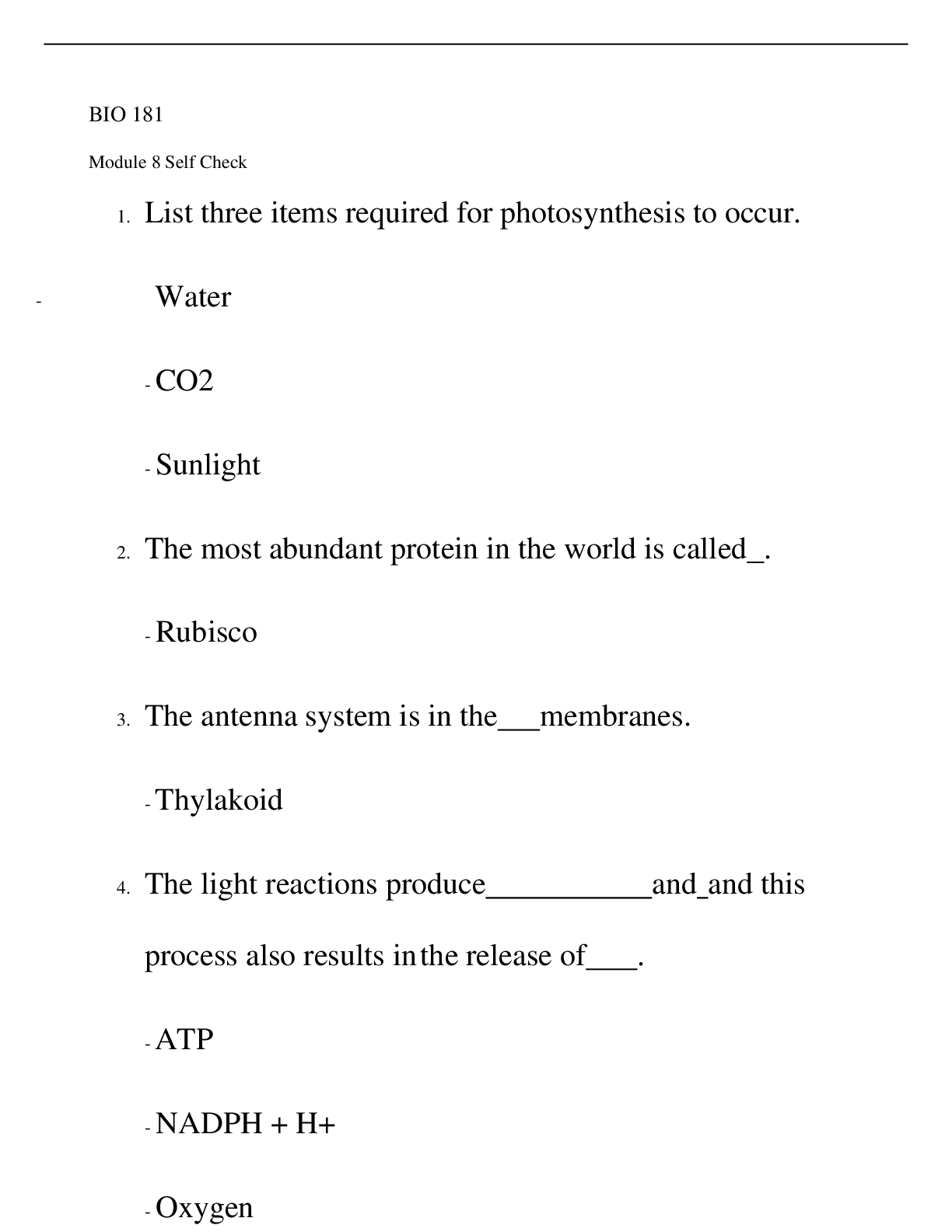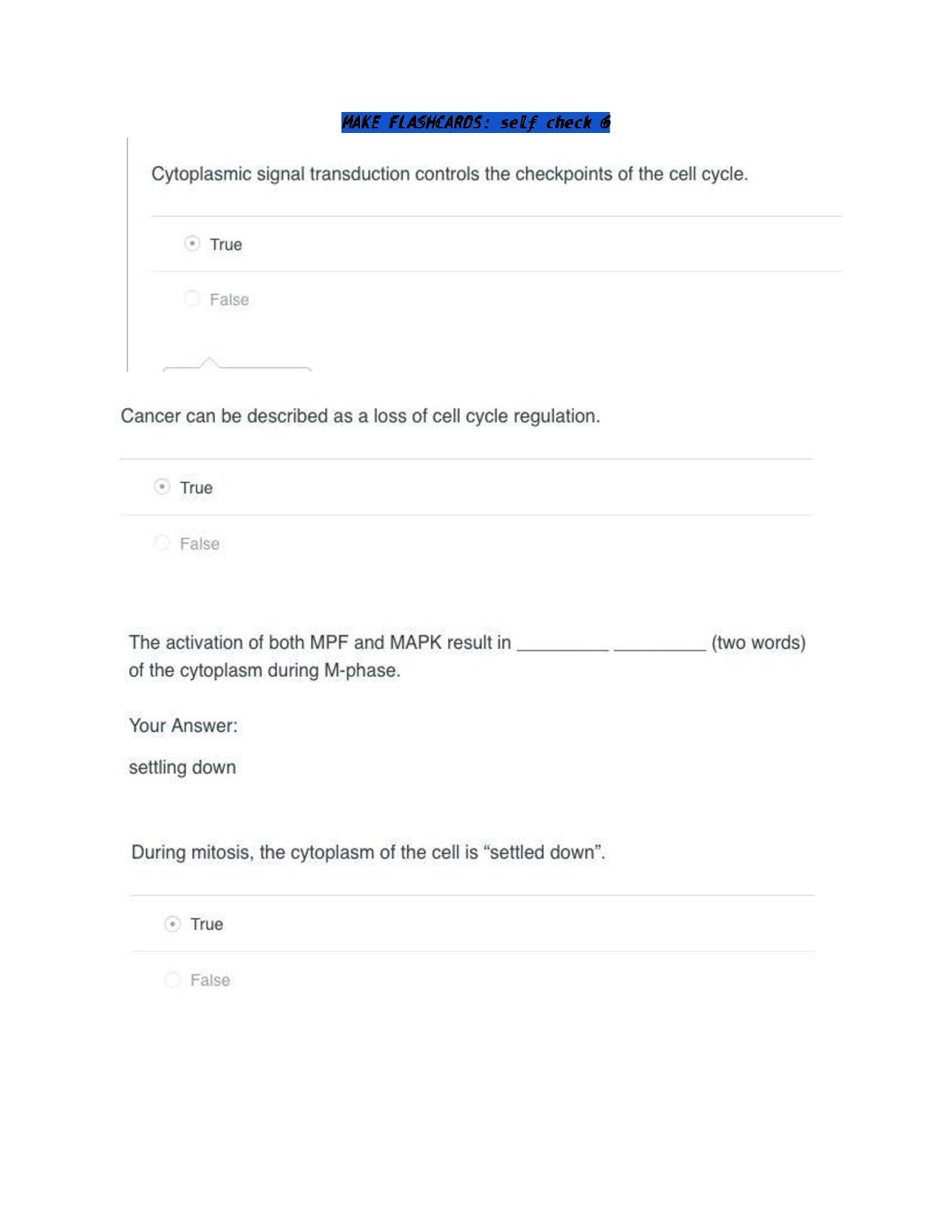Biology > QUESTIONS & ANSWERS > Arizona State University >Self-Checks - Bio 181 Module 1-16 Self Check _all questions and answers | (All)
Arizona State University >Self-Checks - Bio 181 Module 1-16 Self Check _all questions and answers | (2020/2021)
Document Content and Description Below
Self-Checks - Bio 181 Module 1 Self Check 1. The paramecium swims by way of using a flagella. • 2. In order to examine cells which are smaller than can be detected by the human senses, what needs to... be used? (pick the best answer). 3. A normal cell is anchorage-dependent for growth and mortal. • 4. A single-celled eukaryotic organism: 5. In your own multicellular body, different cells in your body have a division of labor between them. • 6. In your own multicellular body, cells with different functions have different DNA. • 7. Compared to bacteria which of the cell types below are not responsible for finding food 8. A cell that is anchorage-dependent for growth will also exhibit contact inhibition. • 9. In Cell Biology what can limit the progress of science? 10. A cancer cell will be anchorage-dependent for growth and immortal. • 11. The contractile vacuole of the paramecium is possibly an evolutionary precursor of the kidney. • 12. The paramecium discussed in class contained an organelle called the contractile vacuole. This is the presumed precursor of the: 13. Comparing a single-celled eukaryotic organism with a multicellular organism such as yourself identify the major difference from the list below. 14. A cell that is itself an organism must have a minimum of four needs presented in lecture. List these four things. 15. Write a few sentences that explain what limits an individual cell from becoming more complex. 16. What limits the paramecium from acquiring more complex functions? Module 2 Self Check 1. A normal cell is and for growth. 2. In an extant prokaryotic cell, the outer boundary of life is the capsule. • 3. The cytoskeleton enabled the primitive cell to become motile. • 4. Loss of the cell wall is required for the endosymbiotic theory. • 5. DNA in extant prokaryotic cells is circular. • 6. It is presumed that the peroxisomes evolved in these primitive, proto-eukaryotes to remove oxygen, which was toxic to the primitive cells. • 7. What limits how big a cell can be? 8. The presumed first step in the transition of the primitive, proto-prokaryotic cell into the primitive, proto-eukaryotic cell was the loss of the cell wall. • 9. List one limitation of the cell culture technique. 10. Ribosomes bound to some of the membrane invaginations in the endomembrane theory. • 11. The cytoskeleton gave rise to the nuclear envelope. • 12. The ancient earth did not contain much oxygen. • 13. Finish the sentence based on my lectures: The association of ribosomes with invaginations would support the theory. 14. Fluorescence microscopy is a form of light microscopy. • 15. The end of the retraction fiber touching the cell culture plate still contains the cell equivalent of super-glue. • 16. TEM provides a thin, two-dimensional section of the object being studied. • 17. Motility improved the fitness of these early cells because: 18. Loss of the cell wall was required for the endomembrane system theory. • 19. When cancer cells are crowded by surrounding cells, the cancer cells become spherical and they can still go through cell division. • 20. After a cell is pancake shaped in a cell culture dish, the order of events that occurs as a cell walks is (pick the best order): • 21. Why is it important to know the limitations of technology? Module 3 Self Check 1. When a vesicle fuses with the plasma membrane the contents of the lumen of the vesicle are: 2. For a protein to enter the endoplasmic reticulum as part of the endoplasmic reticulum’s lumen or part of the endoplasmic reticulum’s membrane: 3. The ER is contiguous with the Golgi apparatus. • 4. Facilitated diffusion uses a channel protein to let components move down their concentration gradient. • 5. Active transport uses ATP to move components in parallel with their concentration gradient, that is: from a high concentration to a low concentration. • 6. The ER is contiguous with the nuclear envelope. • 7. It is a simple matter (i.e., thermodynamically favorable) for a vesicle to form from the endoplasmic reticulum. 8. A single pass trans-membrane protein that is an alpha helix can make a channel. 9. The plasma membrane gets new lipids from: 10. Explain the evolutionary origin of mitochondria. 11. Draw a phospholipid and make sure the numbers of carbons are clearly identified. 12. What are the orphaned organelles orphaned from? 13. What is the difference between a triglyceride and a phospholipid? 14. What are the two functions of a membrane? 15. Amino acids can be largely subdivided into two groups. What are the two groups? 16. Cholesterol is to have in biological membranes. 17. Explain the evolutionary origin of the endoplasmic reticulum, Golgi apparatus and vesicles. 18. Explain how the vesicles are carried from the Golgi apparatus to the plasma membrane. 19. We are made up of percent water. 20. If something is soluble in water a of hydration forms around it and it is termed. 21. What is the difference between a single-pass transmembrane protein and a 7- pass transmembrane protein? Module 4 Self Check 1. To get into the nucleus a component has to have the correct signal sequence and pass through a nuclear pore. • 2. Chromosomes are made out of Euchromatin. • 3. Naked DNA does not exist in nature, but scientists can make naked DNA in a test tube. • 4. Molecular motors use ATP as the energy source to power the molecular motors. • 5. Heterochromatin does not exist in interphase nuclei. • 6. The diameter of an intermediate filament is 25 nm. • 7. The actin filament system extends outside of the cell. • 8. Cilia and microvilli contain a similar number of parallel actin filaments. • 9. The actin filament system is present in the nucleus. • 10. Which cytoskeletal filament system lines the inside of the nucleus to protect it? 11. Consider the geography of cells. Actin filaments are present in the cell’s and the microtubules are present in the cell’s. 12. What does the nucleosomal core have in it (i.e., the basket ball like structure on the slides)? 13. Molecular motors run on which two cytoskeletal filament systems? 14. Where is the histone H1 found? • Module 5 Self Check 1. MAPK has two different functions depending on where this kinase acts in the (two words). If the kinase becomes active during interphase the cell is triggered to progress through the (two words). • ? 2. When a cell “talks to itself” it is called communication. • Autocrine 3. There are two basic forms of cytoplasmic signaling (i.e. signal transduction). One uses and the other uses . • Calcium signal, protein kinases 4. For a cell to respond to a ligand released from a neighboring cell where the ligand diffuses directly from one cell to another is called communication. • Paracrine 5. There are two basic types of communication within cells. One type is called signaling and it takes days to weeks to occur. The other type is called communication and it takes minutes to hours to act. • Nuclear, cytoplasmic (signaling) 6. The other point where MAPK can become active is of the cell cycle. • M phase 7. For a cell to respond to a ligand released from a cell and uses the circulatory system to get to the responding cell it is called communication. • Endocrine 8. Two types of second messengers discussed in lecture can exist downstream of a plasma membrane receptor. These are and . • Calcium ions and cyclic nucleotides 9. There are two types of receptors. One type of receptor binds to polar (hydrophilic) ligands and this is the receptor located in the (two words). • Plasma membrane 10. There is communication between cells and communication cells. • Within 11. When insulin binds to a receptor, this signal first uses . • Kinases Module 6 Self Check 1. The synthesis/presence of cyclin is what turns on the Cdk as the Cdk is always present but it is the cyclin that is synthesized and degraded in cycles. • .................CONTINUED....DOWNLOAD TO BOOST YOUR GRADES.......... [Show More]
Last updated: 1 year ago
Preview 1 out of 28 pages
Instant download
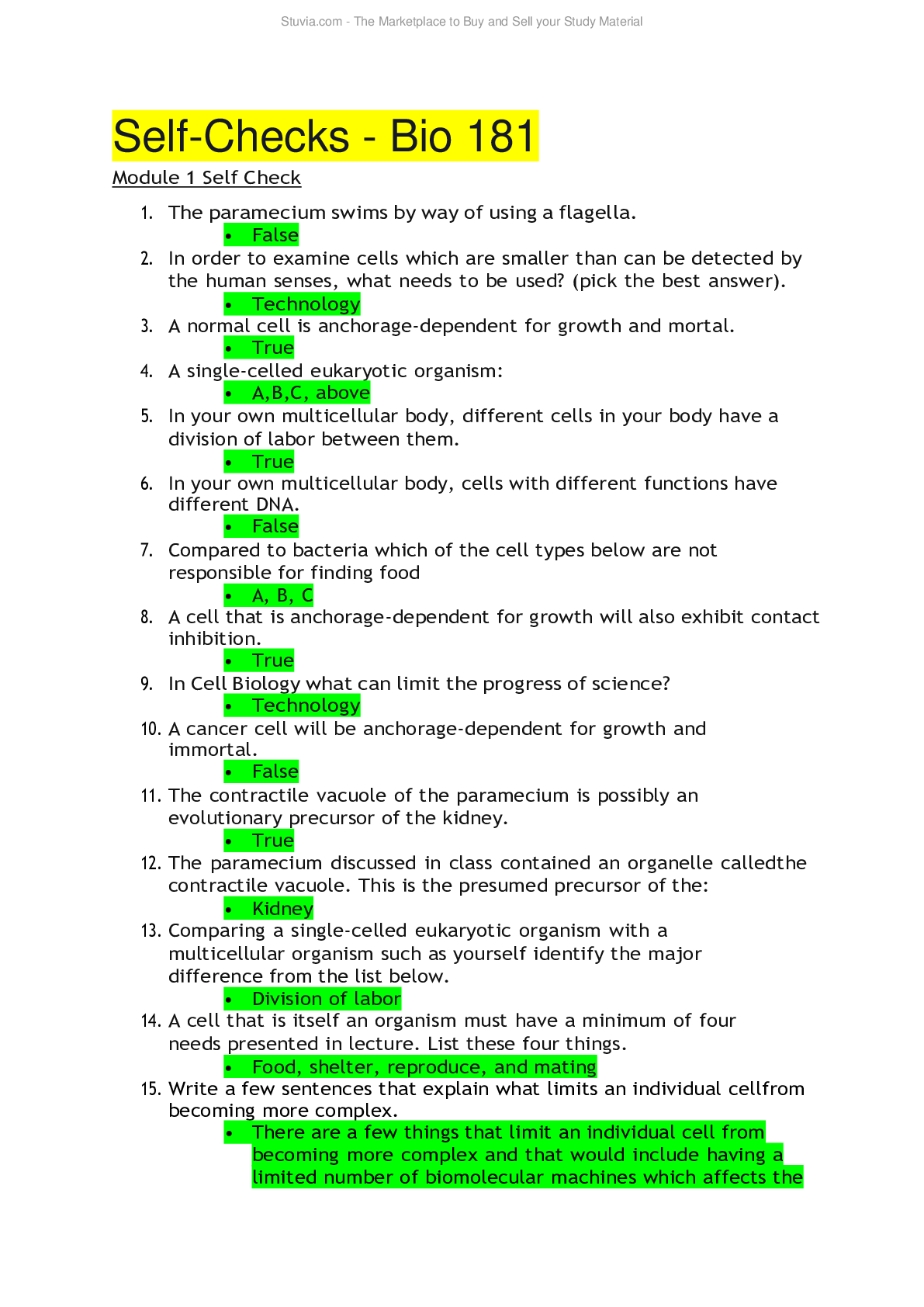
Buy this document to get the full access instantly
Instant Download Access after purchase
Add to cartInstant download
Reviews( 0 )
Document information
Connected school, study & course
About the document
Uploaded On
May 12, 2021
Number of pages
28
Written in
Additional information
This document has been written for:
Uploaded
May 12, 2021
Downloads
0
Views
27


